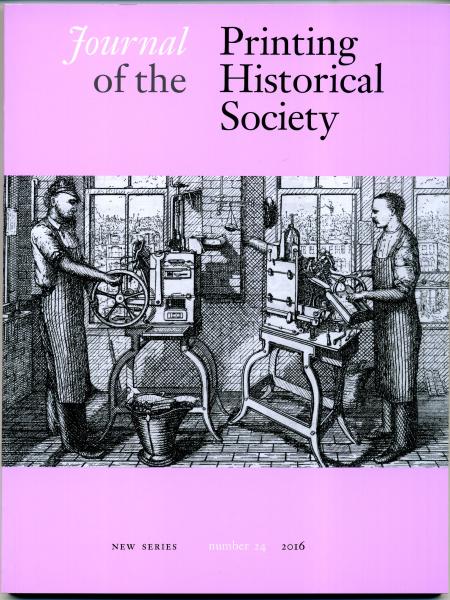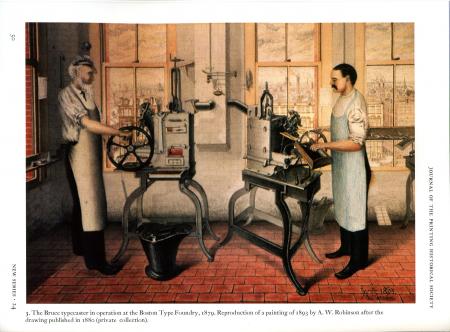Bruce pivotal type caster
I’m pleased to report that number 24 of the Journal of the Printing Historical Society is out now, with my article “The Bruce pivotal typecaster and its influence on nineteenth-century typography.” In 26 pages it covers early attempts at machine typecasting, leading up to the successful Bruce caster of 1838. The cover shows the Bruce caster in use at the Boston Type Foundry in 1879. The same scene is shown in color in the article, and it is the only color image showing the inside of a nineteenth-century type foundry that I am aware of.

PHSJournal24.jpg

PHSJournal24colourplate.jpg
Excellent article by Steve - and many other extremely readable features in this issue, including a brand-new survey of wooden (Common) presses in the UK. Highly recommended.
Indeed a very good issue of the Journal.
I wonder, if one visited some old folks homes near Sheffield, you might yet find someone who could recall using these machines, or did Stephenson Blake use something different?. What make are those machines standing in a long silent and seemingly neglected row in the London Type Museum?, were they from S.B. & co? . .
Yes, they are all ex-SB&Co, but it’s unlikely that anyone still alive can operate them. Some are really ancient, with pots which were originally coal-fired.
The machines at the Type Archive are among the oldest surviving SB examples. Neglected? Not really. They are stored in clean, dry, heated conditions, just a few feet away from a working Monotype installation, with Composition and Supercasters in regular use alongside.
The last remaining operator of the pantographic engraving machinery at DeLittle Wood Letter (York) was invited to the Type Archive a little while ago to advise on the operation of the machinery stored at Stockwell. He is long retired, but the early stages of dementia had already seriously affected his memory and he could not assist at all. These skills need to be handed down as soon as possible to avoid similar situations arising in the future.
Luckily more pivotal casters have survived. The Plantin Moretus Museum just auctioned off a pivotal caster given to them in the 1960’s once used by the Clarendon press for casting their matrices.
Indeed the knowledge to use this machine was lost, but thanks to training received at the late Dale Guild Typefoundry and the information received from Stan Nelson, we have (that is me and Hugh Macfarlane) succeeded in getting it back to work. Already last year some experiments were executed on another English pivotal (Williams) with moderate succes.
The last few days we managed also to get the three US pivotal casters, which were formally the Dale Guild’s, up and running.
This only could happen because Hugh spent the last few months at his home restoring a 1911 Davis pivotal caster coming from a foundry in Morpeth. This machine stood outside for a couple of years, but again is in working condition, ready to produce type.
It is our future intention to spent some time on restoring another two pivotal’s, and any person who seeks information on getting pivotal’s back in working order are very welcome to get in contact for any advice or help.
Patrick and Hugh
Project Letter-kunde
Letter-kunde press and type foundry
I have only a couple of minor things to add -
- @InkSprite - Jim DeLittle was in fact able to help a little when he came down though, as you say, his mental health wasn’t great. I took lots of photos, asked lots of questions, and took lots of notes. Given a solid weekend, I don’t think it’d be too hard to get everything going again. The trouble is finding that solid weekend. I’m working on it.
- I met with Ernie Crapper, the last foreman of Stephenson Blake’s casting room, a few months before he died in June 2015, and had a lovely morning with him and his wife. With his passing, I don’t think there are any first-hand operators of the Stephenson Blake casting machines still around. I have only limited experience of pivotals, but the SBs are much more heavy-duty and involved than the smaller casters that Patrick, Hugh and I have. Principles are, of course, the same, but the margin of error is smaller, and the potential damage to operator and machine is much larger.
- Delighted to hear about Patrick & Hugh’s experiments. Very exciting. Onward!
nick